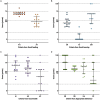Animal welfare assessment protocol for quails reared for meat production
- PMID: 39403213
- PMCID: PMC11471728
- DOI: 10.3389/fvets.2024.1452109
Animal welfare assessment protocol for quails reared for meat production
Abstract
Introduction: It is estimated that 1.4 billion quails are reared each year for their eggs and meat, but animal welfare assessment protocols for this species have yet to be established. The objective of this study was to devise an animal welfare assessment protocol developed through a multidimensional approach that contained a number of animal-based indicators (ABIs) for quails (Coturnix japonica) reared for meat production.
Methods: During 2021 and 2022, the identical auditor visited and audited 14 Spanish farms in their initial year of integration into an animal welfare certification scheme. The protocol is categorised into 4 principles and 12 criteria. The "good feeding" principle includes 6 indicators (1 ABI), "good housing" includes 10 indicators (5 ABIs), "good health" includes 12 indicators (9 ABIs), and "appropriate behaviour" contains 8 indicators (5 ABIs). The final welfare assessment is calculated at the farm level using scores from the on-farm recordings. The assessment is a step-by-step weighted sum of the scores from the various indicators, with the final score ranging between 0 and 100.
Results and discussion: The main welfare issues found on all farms were a lack of temperature and humidity records, a poor lighting pattern, and the absence of an outdoor range or access to one. To a lesser degree, it was also found that there were excessive numbers of birds per feeder, the presence of improperly functioning drinkers (i.e., not working, inadequate water flow, or dripping water), poor litter quality, and a high prevalence of birds with dirty plumage and lameness. Despite this, the farms achieved a good overall score, being classified as "enhanced" (n = 11) and "acceptable" (n = 3). The tool proved helpful in identifying specific welfare issues at the farm level and conducting benchmarking.
Keywords: animal-based protocol welfare; assessment protocol; behaviour; certification; feeding; health; housing; outputs.
Copyright © 2024 Dalmau, Padilla, Varvaró-Porter, Xercavins, Velarde and Contreras-Jodar.
Conflict of interest statement
The authors declare that the research was conducted in the absence of any commercial or financial relationships that could be construed as a potential conflict of interest. The author(s) declared that they were an editorial board member of Frontiers, at the time of submission. This had no impact on the peer review process and the final decision.
Figures


References
-
- Minvielle F. The future of Japanese quail for research and production. Worlds Poult Sci J. (2004) 60:500–7. doi: 10.1079/WPS200433 - DOI
-
- Cheng KM, Bennett DC, Mills AD. The Japanese Quail, The UFAW handbook on the care and Management of Laboratory and Other Research Animals. Wiley; (2010). 655–673
-
- FAOSTAT . Food and agriculture data, Food and agriculture Organization of the United Nations. (2023)
-
- Ionità L, Pana CO, Stanca C, Marin M. Researches regarding the influence of compound feed on growth replacement of young quails. The International Session of Scientific Communications of the Faculty of Animal Science. Series D, Animal Science: (2010). p. 131–137
LinkOut - more resources
Full Text Sources

